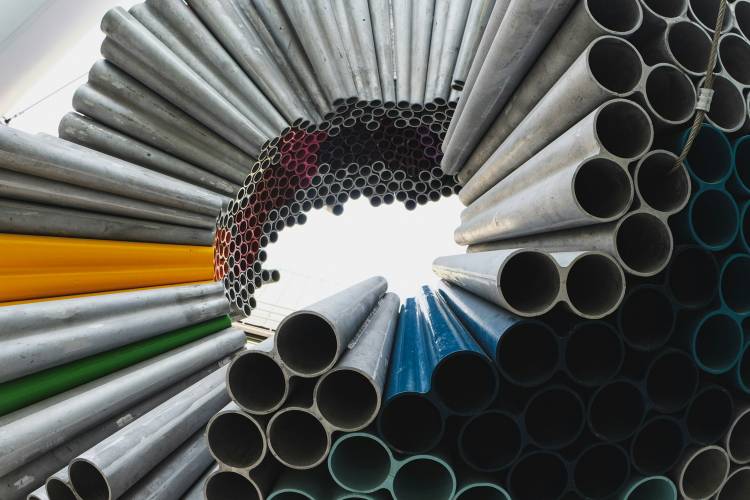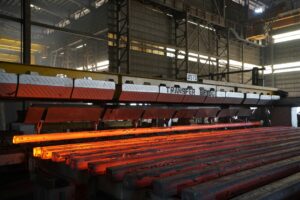
India’s steel industry finds itself at a precarious juncture. Once buoyed by post-pandemic infrastructure push and rising domestic demand, the sector is now grappling with a confluence of adverse developments. External pressures—ranging from renewed US tariff threats to rising Chinese exports—have been compounded by internal headwinds such as early monsoon onset, tepid infrastructure activity, and a steep correction in steel prices. The result is a market caught in a cyclical slump, just when policymakers and producers had begun anticipating a revival.
Even before these domestic concerns took hold, the industry had anticipated turbulence from rising imports. In response, the Directorate General of Trade Remedies (DGTR) recommended a provisional safeguard duty of 12% on select steel products, including imports from China and Vietnam, in March. The immediate impact was a modest price uptick. Benchmark hot rolled coil (HRC) prices rose from ₹46,600 per tonne in January to a peak monthly average of ₹52,900 per tonne in late April (excluding Mumbai). However, by June 24, trade-level prices had declined 4%, reflecting weakening demand across user industries.
READ | Gender backlash erupts after shillong ‘honeymoon murder’
Slipping demand, mounting inventories
The pressure is most acute at the distributor level. Inquiry volumes have dropped, and the conversion of leads into confirmed orders remains sluggish. Firms that had braced for a Chinese export surge now find themselves unprepared for the sharp drop in local demand. In the long steel segment, used mainly in construction, blast furnace rebar prices dropped by ₹1,300 per tonne week-on-week to ₹51,900 (ex-Mumbai). In the projects market, they fell further to ₹51,000–51,500 per tonne, hurt by the monsoon slowdown and persistent bid-offer mismatches.

Adding to the glut, Indian steel exports have stagnated. Most producers remain over-reliant on the domestic market, which absorbed the lion’s share of the 145 million tonnes produced in 2024. Exports to the US amounted to just 95,000 tonnes—negligible in the global context—yet the potential loss of even this market is cause for concern.
A familiar transatlantic dispute
The trade dispute with the United States continues to simmer. India has challenged the steep 25% US tariff on its steel and aluminium exports at the World Trade Organisation, arguing that the measure is tantamount to a safeguard action without due process. Washington, for its part, has justified the duties on national security grounds—a contentious interpretation under WTO norms.
In a recent escalation, former President Donald Trump proposed doubling these tariffs to 50%, raising the spectre of deeper market erosion for Indian firms. Industry analysts estimate that the initial 25% duty alone wiped out nearly $5 billion in market value for Indian exporters.
However, this is not a uniquely Indian problem. The global steel sector is in churn, plagued by chronic overcapacity, tightening trade barriers, and rising geopolitical risk. The US, European Union, and Japan have all imposed a mix of tariffs and quotas in recent years to shield their domestic industries from volatile global flows.
Return of the China factor
Amid a sluggish economic recovery, Chinese steelmakers are once again turning to exports. Beijing’s crude steel production fell 1.7% year-on-year in the January–May period, but exports rose 8–10% during the same timeframe. If the US and other advanced markets raise barriers further, Chinese producers are likely to redirect excess capacity to Asian markets—including India.
That should ring alarm bells. India is in the middle of a capital investment cycle in steel, with significant capacity being added under the government’s National Steel Policy and the production-linked incentive (PLI) scheme for specialty steel. Allowing a flood of cheaper Chinese imports risks derailing this fragile investment momentum.
Strategy for steel industry revival
Yet, protection cannot be indiscriminate. A blanket safeguard duty could choke critical imports in niche categories where Indian production is inadequate or non-existent. High-end segments such as aerospace, defence, and precision automotive applications require advanced steel grades that domestic mills are yet to master. For these, selective and calibrated import access remains essential.
The PLI scheme for specialty steel, launched in 2021, aims to address this deficiency by incentivising capacity in high-grade alloyed and coated products. However, progress has been slow, and the scheme requires sustained policy push and investment follow-through to yield results.
A better alternative lies in targeted, country-specific tariffs. Such measures would deter dumping without disrupting access to essential inputs. For instance, imports from economies with demonstrated overcapacity and a history of undercutting—such as China—can be subjected to tariff discipline, while maintaining open channels for value-added and technical steels.
Turning inward, looking outward
India’s steel firms must also broaden their export horizons. With the US market under stress, opportunities lie in Southeast Asia (Vietnam, Thailand), the Middle East (UAE), and parts of Africa. Meanwhile, the India-UK Free Trade Agreement, which removes tariffs on 99% of Indian exports, offers an avenue for market diversification once finalised.
Domestically, demand is expected to pick up once the monsoon recedes and infrastructure outlays kick in. While April saw a dip in apparent steel consumption to 10.93 million tonnes—down from 12.96 million tonnes in March—the long-term trajectory remains upward, particularly in roads, housing, and renewable energy.
In this context, the government’s role should be twofold: impose calibrated protections against predatory pricing from abroad, and accelerate reforms that strengthen domestic capability, especially in advanced steel technologies.
The next quarter will be critical. If India navigates the immediate pressures with foresight and policy discipline, its steel sector could emerge stronger—and more competitive—in the global marketplace.
